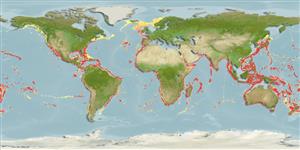Environment: milieu / climate zone / depth range / distribution range
Ecologia
marino benthopelagico; distribuzione batimetrica 200 - 1200 m (Ref. 6181). Deep-water; 70°N - 47°S, 180°W - 180°E
Probably distributed worldwide in tropical and subtropical seas except in eastern Pacific and northern Indian oceans. Large-sized individuals stray in cold-temperate waters off Iceland, Norway, northern Japan and southern New Zealand (Ref. 6181). Reported from 19°41'S, 79°11'W (Ref. 11892).
Size / Peso / Age
Maturity: Lm ? range ? - ? cm
Max length : 130 cm SL maschio/sesso non determinato; (Ref. 6181); common length : 80.0 cm SL maschio/sesso non determinato; (Ref. 6181)
Spine dorsali (totale): 20 - 22; Raggi dorsali molli (totale): 19-24; Spine anali 2; Raggi anali molli: 18 - 21; Vertebre: 34 - 36. Body fairly elongate and strongly compressed. Mouth with fang-like teeth. The tips of both jaws with dermal processes. Gill rakers degenerated. Color is dark brown with violet tint; fin membranes black; margin of anus black (Ref. 6181).
Adults, benthopelagic to mesopelagic, dwell on the continental slope or underwater rises, migrating to midwater at night (Ref. 6181). Eggs are pelagic (Ref. 6766). Larvae and juveniles, epipelagic to mesopelagic, are rather common in oceanic ichthyoplankton and are only found in the tropics (Ref. 6181). Feed on squid, fish and crustaceans (Ref. 6181). Consumed as food (Ref. 4537).
Nakamura, I. and N.V. Parin, 1993. FAO Species Catalogue. Vol. 15. Snake mackerels and cutlassfishes of the world (families Gempylidae and Trichiuridae). An annotated and illustrated catalogue of the snake mackerels, snoeks, escolars, gemfishes, sackfishes, domine, oilfish, cutlassfishes,. scabbardfishes, hairtails, and frostfishes known to date. FAO Fish. Synop. 125(15):136 p. (Ref. 6181)
IUCN Red List Status (Ref. 130435)
Threat to humans
Harmless
Human uses
Pesca: scarso interesse commerciale
Informazioni ulteriori
BibliografiaAcquacolturaProfilo di acquacolturaVarietàGeneticaElectrophoresesEreditarietàMalattieElaborazioneNutrientsMass conversion
Strumenti
Special reports
Download XML
Fonti Internet
Estimates based on models
Preferred temperature (Ref.
123201): 6.6 - 14.3, mean 9.6 °C (based on 988 cells).
Phylogenetic diversity index (Ref.
82804): PD
50 = 1.0000 [Uniqueness, from 0.5 = low to 2.0 = high].
Bayesian length-weight: a=0.00363 (0.00163 - 0.00807), b=3.10 (2.91 - 3.29), in cm total length, based on LWR estimates for this (Sub)family-body shape (Ref.
93245).
Trophic level (Ref.
69278): 4.3 ±0.71 se; based on food items.
Resilienza (Ref.
120179): Basso, tempo minimo di raddoppiamento della popolazione 4.5 - 14 anni (Preliminary K or Fecundity.).
Fishing Vulnerability (Ref.
59153): Very high vulnerability (90 of 100).
Nutrients (Ref.
124155): Calcium = 10.7 [5.1, 22.9] mg/100g; Iron = 0.283 [0.121, 0.617] mg/100g; Protein = 16.5 [14.4, 18.5] %; Omega3 = 0.266 [0.107, 0.654] g/100g; Selenium = 20.2 [5.3, 65.7] μg/100g; VitaminA = 14.7 [3.3, 68.7] μg/100g; Zinc = 0.266 [0.129, 0.522] mg/100g (wet weight);
